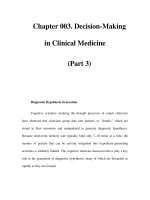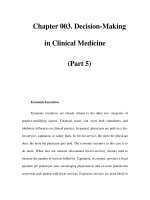Chapter 003. Decision-Making in Clinical Medicine (Part 4) doc
Bạn đang xem bản rút gọn của tài liệu. Xem và tải ngay bản đầy đủ của tài liệu tại đây (13.6 KB, 5 trang )
Chapter 003. Decision-Making
in Clinical Medicine
(Part 4)
Major Influences on Clinical Decision-Making
More than a decade of research on variations in clinician practice patterns
has shed much light on forces that shape clinical decisions. The use of heuristic
"shortcuts," as detailed above, provides a partial explanation, but several other key
factors play an important role in shaping diagnostic hypotheses and management
decisions. These factors can be grouped conceptually into three overlapping
categories: (1) factors related to physicians' personal characteristics and practice
style, (2) factors related to the practice setting, and (3) factors related to economic
incentives.
Factors Related to Practice Style
One of the key roles of the physician in medical care is to serve as the
patient's agent to ensure that necessary care is provided at a high level of quality.
Factors that influence this role include the physician's knowledge, training, and
experience. It is obvious that physicians cannot practice evidence-based medicine
(EBM; described later in the chapter) if they are unfamiliar with the evidence. As
would be expected, specialists generally know the evidence in their field better
than do generalists. Surgeons may be more enthusiastic about recommending
surgery than medical doctors because their belief in the beneficial effects of
surgery is stronger. For the same reason, invasive cardiologists are much more
likely to refer chest pain patients for diagnostic catheterization than are
noninvasive cardiologists or generalists. The physician beliefs that drive these
different practice styles are based on personal experience, recollection, and
interpretation of the available medical evidence. For example, heart failure
specialists are much more likely than generalists to achieve target angiotensin-
converting enzyme (ACE) inhibitor therapy in their heart failure patients because
they are more familiar with what the targets are (as defined by large clinical trials),
have more familiarity with the specific drugs (including dosages and side effects),
and are less likely to overreact to foreseeable problems in therapy such as a rise in
creatinine levels or symptomatic hypotension. Other intriguing research has shown
a wide distribution of acceptance times of antibiotic therapy for peptic ulcer
disease following widespread dissemination of the "evidence" in the medical
literature. Some gastroenterologists accepted this new therapy before the evidence
was clear (reflecting, perhaps, an aggressive practice style), and some
gastroenterologists lagged behind (a conservative practice style, associated in this
case with older physicians). As a group, internists lagged several years behind
gastroenterologists.
The opinion of influential leaders can also have an important effect on
practice patterns. Such influence can occur at both the national level (e.g., expert
physicians teaching at national meetings) and the local level (e.g., local
educational programs, "curbside consultations"). Opinion leaders do not have to be
physicians. When conducting rounds with clinical pharmacists, physicians are less
likely to make medication errors and more likely to use target levels of evidence-
based therapies.
The patient's welfare is not the only concern that drives clinical decisions.
The physician's perception about the risk of a malpractice suit resulting from either
an erroneous decision or a bad outcome creates a style of practice referred to as
defensive medicine. This practice involves using tests and therapies with very
small marginal returns to preclude future criticism in the event of an adverse
outcome. For example, a 40-year-old woman who presents with a long-standing
history of intermittent headache and a new severe headache along with a normal
neurologic examination has a very low likelihood of structural intracranial
pathology. Performance of a head CT or magnetic resonance imaging (MRI) scan
in this situation would constitute defensive medicine. On the other hand, the
results of the test could provide reassurance to an anxious patient.
Practice Setting Factors
Factors in this category relate to the physical resources available to the
physician's practice and the practice environment. Physician-induced demand is a
term that refers to the repeated observation that physicians have a remarkable
ability to accommodate to and employ the medical facilities available to them.
One of the foundational studies in outcomes research showed that physicians in
Boston had an almost 50% higher hospital admission rate than did physicians in
New Haven, despite there being no obvious differences in the health of the cities'
inhabitants. The physicians in New Haven were not aware of using fewer hospital
beds for their patients, nor were the Boston physicians aware of using less
stringent criteria to admit patients. In both cities, physicians unconsciously
adopted their practice styles to the available level of hospital beds.
Other environmental factors that can influence decision-making include the
local availability of specialists for consultations and procedures, "high tech"
facilities such as angiography suites, a heart surgery program, and MRI machines.









